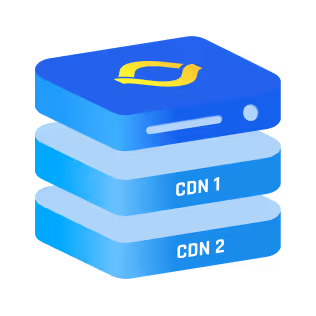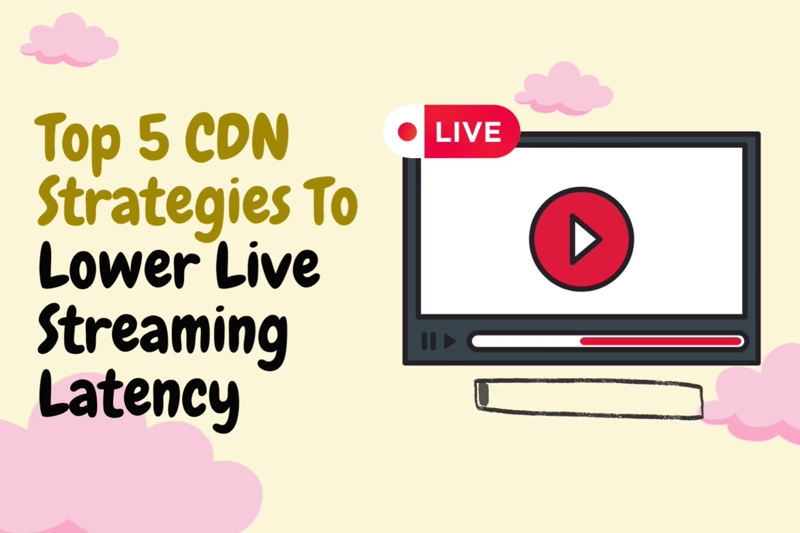Multi-CDN Switching Methods, Benefits, and Challenges
Improve speed, uptime, and reliability with multi-CDN switching. Explore key methods, benefits, and common challenges.

You want your content to reach everyone, fast and without fail. But relying on one CDN (Content Delivery Network) isn’t enough anymore. Performance can drop, outages happen, and costs stack up.
That’s where you come across multi-CDN switching. It gives you control—real-time control—to route traffic through the best-performing CDN at any given moment.
What Is Multi-CDN Switching?
Multi-CDN switching is when you use more than one content delivery network (CDN) and actively choose which one to serve content from—based on speed, uptime, location, cost, or even real-time outages.
You're not guessing which CDN is best. You’re measuring. Monitoring. Then switching on the fly. Instead of depending on one network’s infrastructure, you build a smarter system that adapts to changing conditions—automatically.
{{promo}}
Multi-CDN Switching and Global Reach
Not all CDNs are built the same—and nowhere is that more obvious than when you go global. A provider that’s lightning-fast in the US might struggle in Southeast Asia.
Another might dominate Europe but fall flat in South America. That’s why multi-CDN switching is such a game-changer for global reach.
In regions where infrastructure is shaky, some CDNs suffer from outages, slow TTL updates, or bad ISP routing. Switching lets you skip those chokepoints.
Multi-CDN Switching Methods
There’s more than one way to switch between CDNs—and the method you pick depends on what you’re optimizing for: speed, reliability, cost, or control:
1. DNS-Based Multi-CDN Switching
This is the most widely used method. Here’s how it works: when a user makes a request, your DNS provider decides which CDN to direct them to. That decision can be based on:
- Geolocation (serve from the closest CDN)
- Availability (avoid a downed provider)
- Latency (pick the fastest one at the moment)
Multi CDN DNS is simple, scalable, and works at the edge—but it’s not real-time. Once a DNS record is cached, the user might stick with that CDN until the TTL expires.
2. Client-Side Switching
This puts logic inside your player or app. It tests different CDNs directly from the user’s device and chooses the best one on the spot.
It’s often used in video streaming because players can adapt in real-time based on network performance.
Pros:
- Real-time decision-making
- Great for optimizing video delivery
Cons:
- Requires more development effort
- Not ideal for static content
3. Multi-CDN Load Balancing
This works like traditional server load balancing—just across multiple CDNs. You can route traffic evenly, or set up weighted rules depending on performance, cost, or even business agreements.
This method pairs well with active cdn monitoring and health checks. If one CDN slows down or fails, traffic is rerouted automatically.
4. Multi-CDN Optimizer Tools
You don’t have to build it all yourself. Tools like Cedexis, NS1, and similar platforms offer multi-CDN optimizer services that combine real user monitoring with smart traffic steering.
These tools often plug into your existing DNS setup and give you powerful control over when and how to switch.
Benefits of Multi-CDN Switching
Done right, multi-CDN switching gives you better performance, stronger reliability, and even smarter cost control. Here's what you get out of it:
- Faster Load Times Worldwide: Not every CDN performs equally in every region. With switching, you can route users to the fastest CDN for their location—cutting down latency and speeding up delivery.
- Better Uptime and Failover: Outages happen. But with multi-CDN load balancing and smart failover logic, you’re covered. If one CDN fails, another kicks in automatically. Your users never hit a blank page—and you stay online even during provider issues.
- Smarter Cost Management: Some CDNs are cheaper during off-peak hours. Others charge based on usage spikes. With cdn monitoring and usage-aware switching, you can route traffic to the most cost-efficient provider in real time—without sacrificing quality.
- Traffic Control at Scale: When you're launching a major event or handling a traffic surge, distributing requests across multiple CDNs keeps things stable. You reduce the risk of overloading a single provider and spread demand across your entire delivery network
- Performance Transparency: Using multi-CDN optimizer tools, you get visibility into how each CDN is performing across geographies and timeframes. That means better insights, more control, and decisions backed by real user data—not guesses.
When to Use DNS-Based Multi-CDN Switching vs. Client-Side Logic
Not all switching methods are built the same—and choosing the right one can save you from a lot of headaches:
Use DNS-Based Switching When…
- You want simplicity and wide compatibility.
DNS switching works for almost any device or browser, with no extra code needed on the client side. - You're delivering static content.
Images, HTML, software downloads, or generic API endpoints work perfectly here. - You’re okay with near-real-time performance.
Since DNS changes are cached (via TTL), it’s not truly instant. But it's fast enough for most use cases—especially if you’re using multi-CDN load balancing to distribute traffic smartly. - You want to integrate with a multi-CDN optimizer.
Many tools like NS1 or Cedexis plug in at the DNS layer and give you traffic steering based on real-time telemetry.
Use Client-Side Logic When…
- You’re streaming video or running a real-time app.
Video players (like HLS.js or Shaka) can switch CDNs mid-session, adapting to changing conditions without user disruption. - You need instant failover.
If one CDN stalls or degrades, your logic can immediately retry another—without waiting for DNS TTLs to expire. - You want deeper user-level metrics.
You can measure actual user latency, buffering, and throughput before making a choice. That’s something DNS alone can’t see. - You control the player or app.
If you’re building a custom frontend or have full access to your delivery layer, client-side logic gives you more precision.
Balancing Performance vs Cost in Multi-CDN Switching
Let’s be honest: you don’t just want performance. You want performance without burning your budget. And this is where smart multi-CDN switching shines. You can tune your traffic flow to balance speed and savings—without making trade-offs that hurt user experience.
Some CDNs charge flat rates. Others spike during high usage. Some charge more for specific regions or file types. If you’re locked into one provider, you’re stuck paying whatever rate they hand you. But with switching, you get options.
You can set rules like:
- Use the cheaper CDN during low-traffic hours.
- Only switch to premium CDNs when latency crosses a threshold.
- Route heavy video content through cost-optimized providers.
- Avoid expensive Tier 1 CDNs in regions where alternatives perform equally well.
The trick is to pair multi-CDN optimizer tools with real-time cost and performance data. That way, your system is choosing the smartest. You save on bandwidth costs, reduce unnecessary overages, and still hit performance targets where they matter.
{{promo}}
Challenges of Multi-CDN Switching
Multi-CDN switching sounds great—and it is—but let’s not sugarcoat it. There are real hurdles you need to be ready for. Complexity goes up. Visibility gets harder.
And mistakes can hurt performance instead of helping it.
- Configuration Complexity: Managing one CDN is simple. Managing two or three? That’s a different story. Each provider has its own setup, caching rules, headers, TLS configs, and APIs. You’ll need to standardize behaviors across CDNs—or risk inconsistent delivery and debugging nightmares.
- DNS Caching and TTL Lag: If you’re using DNS-based multi-CDN switching, cached records can delay failover or make performance decisions feel sluggish. Even if a CDN goes down, users may still get routed to it until the TTL expires—unless you build in aggressive monitoring and smart fallback logic.
- Data Fragmentation: With multiple CDNs in play, your logs, performance metrics, and usage stats are scattered. Unless you consolidate them into a unified cdn monitoring platform, you’ll end up flying blind when something breaks—or worse, when performance subtly degrades over time.
- Debugging Becomes Harder: What happens when one CDN is 10% slower than expected—but only in South Korea, only on iOS, and only on mobile data? That’s the kind of edge case you’re more likely to hit when switching providers dynamically. Without strong observability, you might not even notice until users complain.
- CDN Feature Gaps: Not all CDNs support the same features—like edge compute, token-based auth, or HTTP/3. You may need to compromise on functionality to ensure parity across providers, or use provider-specific logic that makes switching harder to maintain.
Conclusion
If you're serious about performance, reach, and resilience—multi-CDN switching isn’t optional anymore. It gives you the power to route around slowdowns, outages, and overpriced bandwidth.
But it’s not a free win. You’ll need the right tools, the right logic, and a clear plan for handling complexity.
Control the switch, and you control the stream.



.png)
.png)
.png)




